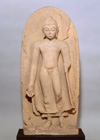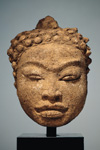 |
  |
|

|
|
| |
Yong
Soon Min |
| |
Yong Soon Min
is a multi-media artist. She was born in Korea and educated in the
United States She received Bachelor of Arts, Masters, and Masters
of Fine Arts degrees from the University of California at Berkeley.
Min's works have been shown in numerous group and solo exhibition
in the United States and abroad. She also lectures, authors articles
and essays, curates exhibitions, and chairs the Department of Studio
Art at the University of California, Irvine. Her latest activities
include works for the Asia Society and a commission to curate a
special exhibition for the 4th Giwangju Bienniale, which will be
held in South Korea from March 31 to June 31, 2002.
Selected
Objects
|
|
 |
|
 |
| |
 |
Buddha
India, Uttar Pradesh, Sarnath area
Gupta period, about 475
Sandstone
H. 34 1/8 in. (86.7 cm); 1979.5
|
This
Buddha embodies an inspiring synthesis of sensuality and serenity. It is
endowed with many subtle, quiet qualities: simplicity, grace, and a disarming
delicacy of expression and form. Sinuous, curvilinear forms repeat throughout
the piece to create a harmonious whole. The Buddha also appears youthful
and sensuous, even feminine with his full lips and the firm roundness of
the body. And yet in his clarity and simplicity of definition, absent of
any severity or stiffness in the pose, this Buddha emanates a powerful sense
of repose and serenity. He would even seem to be suspended, floating, enhanced
by the sandstone's lightness of hue, if not for the anchor of the mandorla
and the base.
|
| |
 |
Female
Attendant
North China
Western Han period, 2nd century B.C.E.
Earthenware with slip and traces of pigment
H. 21 1/2 in. (54.6cm); 1979.110
|
I
am powerfully drawn to her. She compels me to empathize with her. I identify
with her broad, flat, simply defined face and flat feet. The irregular patch
of redness around her face along with the marred and dirtied surface enhance
the sense of pathos that she engenders, given the emotional and social damage
derived from her station in life. She stands tentatively though with such
rigidity in the slim hips, as if to render herself so self-contained, self-restrained,
and diminutive, lest she take up any unwarranted space. And although she
appears quite vulnerable in all her exposed humility and servitude, she
nevertheless commands the kind of honor and dignity of someone who has nothing
left to lose.
I feel eternal gratitude to the anonymous artist who fashioned her with
such honesty, compassion, and conviction. It's a seemingly simple and stylized
portrait with such economy of line and form yet it conveys a powerful sense
of individuality, of an actual person in all her complexity.
|
| |
 |
Storage
Jar
Korea
Three Kingdoms period, Kaya or Early Shilla Kingdom, about 6th century
Stoneware with areas of ash glaze
H. 15 3/4 in. (40.0 cm), D. 16 1/2 in. (41.9 cm); 1981.2
|
I
generally overlook ceramics but this jar caught my eye and kept it glued.
It is so what it is. This work exemplifies well-worn notions that truth-is-beauty
and that less-is-more in its emphatic, matter-of-fact rotundity! The jar
exudes a surprisingly elegant voluptuousness despite or beyond the unadorned
simplicity of its terracotta form. What initially seemed jarring (pun unintended
but acknowledged) and somewhat comical-the tiny worm-like handles, which
defy utility and seem superfluous to the otherwise essentialized form-have
grown to accept and appreciate the wisdom of its inclusion; the jar would
seem unanchored, as it were, without these visual weights.
|
| |
 |
Tirthankara
India, Karnataka or Tamil Nadu
7th-early 8th century
Copper alloy
H. 10 1/2 in. (26.7 cm); 1979.11
|
I'm
a sucker for those love handles! I have to confess that this is what most
attracts me to this figure. They're so pronounced and give this otherwise
stiff statue a human and, I dare say, an endearingly humble and even humorous
quality. Everything else about its physical features is rather bluntly though
vigorously defined with straightforward lines. Its large hands also lend
a rather boyish, gangly quality of one who is yet to attain full maturity.
|
| |
 |
Head
of Buddha
Thailand
Mon style, late 8th-9th century
Stucco
H. 6 in. (15.2 cm); 1979.78
|
| Even
though it is made of rough stucco, the head is exquisite. Its fullness and
roundness of features suggest strong feminine qualities. Moreover, these
features look familiar and bear startling resemblance to some women I know,
conferring to this work an incredible sense of contemporaneity and immediacy.
The severed head also brings to mind an installation project of a fellow
artist, Dinh Le, that involves headless Buddha figures prevalent in the
East coupled with numerous Buddha heads found in prominent Western collections
and the implications of Western hegemony underlying this situation. |
|
|
|




